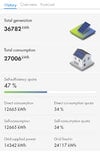Gareth Oakes
Member
You can't directly compare the Redback ST10000 to a single Powerwall 2, because the Tesla option is a single-phase unit, whereas ST10000 is a true three-phase device. Also Redback uses Pylontech LFP batteries whereas Powerwall 2 is Tesla NCM.
When we purchased the Redback our shortlist also included Fronius+BYD and Huawei options. Redback was very slightly cheaper than Huawei and almost $4000 less than Fronius. Our system is a 10kW hybrid inverter with 14.2kWh of battery and 10kW of panels. Purchase price including removal of old system and installation of new inverter, panels, etc. was in the region of $22k from memory. Redback is a single integrated unit including instant switchover to battery backup at no extra cost.
Back then the Powerwall 2 was $14k just for the battery, then you had to add the backup gateway, backup switch, and other electrical components. Adding on the 10kW of panels plus installation fees would have brought it quite close to the Redback cost.
Redback does have a mobile app, web portal, and REST API. I would say the Tesla app and software is more sophisticated, but the Redback software certainly does everything we need.
When we purchased the Redback our shortlist also included Fronius+BYD and Huawei options. Redback was very slightly cheaper than Huawei and almost $4000 less than Fronius. Our system is a 10kW hybrid inverter with 14.2kWh of battery and 10kW of panels. Purchase price including removal of old system and installation of new inverter, panels, etc. was in the region of $22k from memory. Redback is a single integrated unit including instant switchover to battery backup at no extra cost.
Back then the Powerwall 2 was $14k just for the battery, then you had to add the backup gateway, backup switch, and other electrical components. Adding on the 10kW of panels plus installation fees would have brought it quite close to the Redback cost.
Redback does have a mobile app, web portal, and REST API. I would say the Tesla app and software is more sophisticated, but the Redback software certainly does everything we need.



